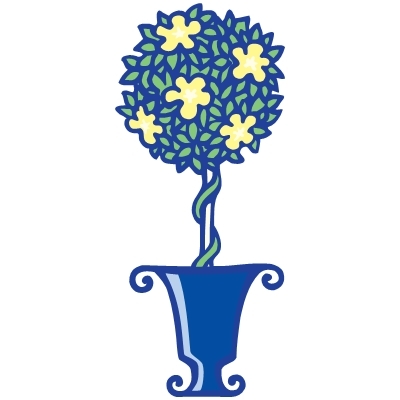
ISAT
International Sightseeing And Training
ISAT
International Sightseeing And Training
Sightseeing Notes
For Copenhagen, North Sjælland
and
Southern Sweden - plus extra notes.
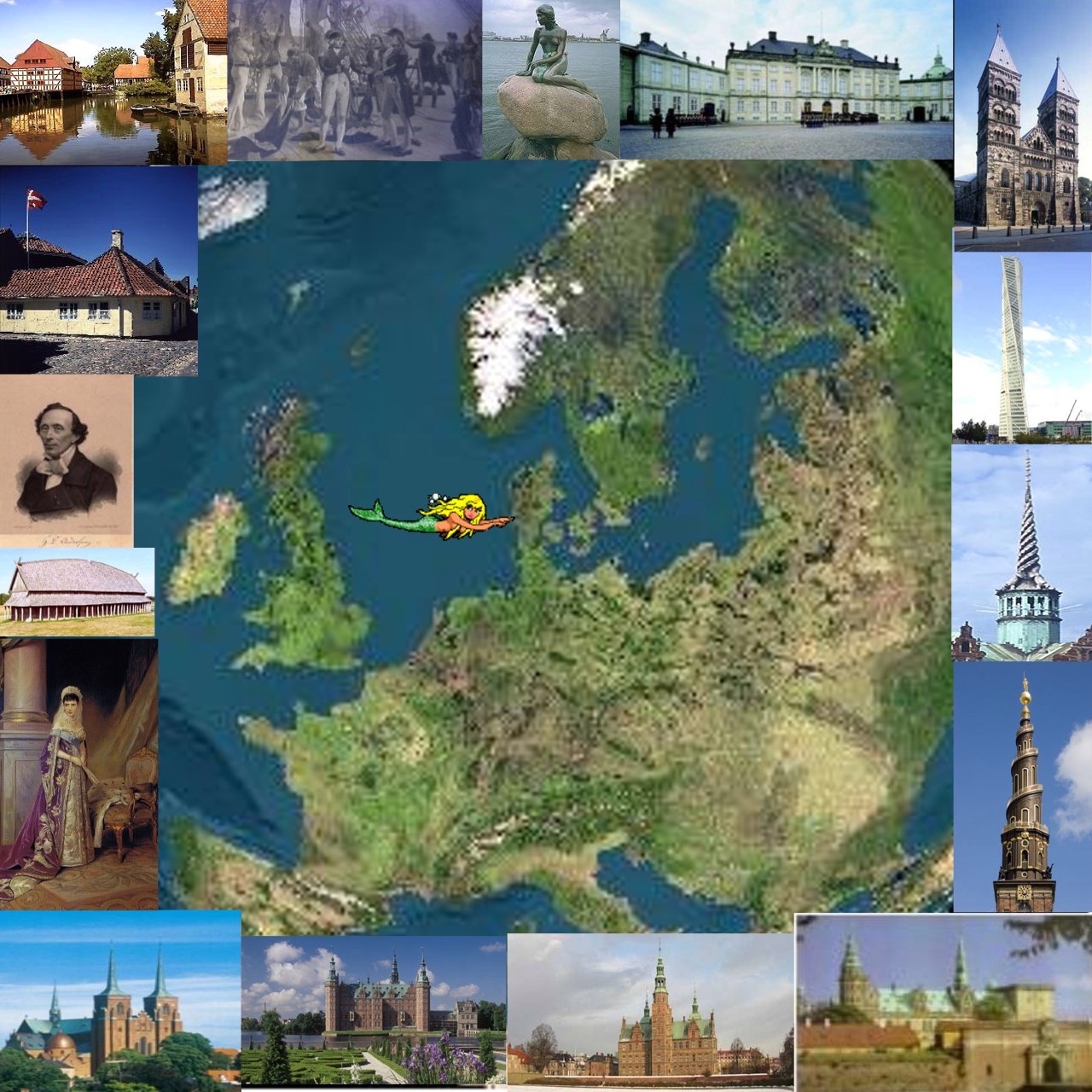
----------------------------------------------------------
Taxi & Limousine - Sightseeing Tours - Copenhagen &
Region
The Copenhagen City Tour
- By Paul H Wilson(Approx 1½ - 3 hours - can be extended to 5 hours)
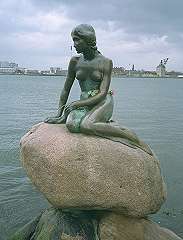
* The Little
Mermaid
Photo Stop
The Little Mermaid was created by Edvard Eriksen, commissioned
by Carl Jacobsen
the founder of Carlsberg Brewery and placed on it's famous stones on 23
August 1913.
From the story by Denmarks most famous writer Hans Christian
Andersen
written in 1837. The story is about a young mermaid who falls in love with
a prince when his ship sank She wants to live with him above the
surface
with him but can not be as she is a mermaid who can only live under
the water and the prince can not live under the water only
above. etc, etc.
* The Little Mermaid - Copenhagens psychological symbol
Has been attacked 8 times by hooligans.
Trekroner Fort ( second fort) 1786 - King Christian Vll.
* Nelson destroys the Danish Fleet during the Napoleonic Wars
- Battle of Copenhagen , 2 April 1801 .
The British war fleet returned and bombarded the City in 1807.
* Burmeister & Wain Shipbuilders -
* Holmen - Danish Royal Navy / The Queens Royal Yacht 'Dannenbrog'
* Kastellet , started by Christian Vl in 1626 and later finished by
Frederik lll in
1663. HQ of Danish military for Sjælland (and soon in
2007 for all of Denmark)
* Langelinie - Germans Landing 1940 / Cruise Ships
* Langelinie Pavillion Restaurant
* Swedish Church - St.Gustavs - tradition for many Swedes to
come and be married
and then easy for access for Copenhagen airport for their honeymoon
* Statue of Christian IV (Born 1577 - became king in 1588 - and died in
1648)
* Nyboder - Navy houses about 400 years old, still mainly used by Danish
Military
* Maersk HQ - largest container fleet etc, Danmarks largest company etc
Maersk Mckinley Moller- richest person in Denmark lives in
Charlottenlund etc
* Toldbod where the queen arrives/departs from Dannenbrog
* Dannebrog - Queens yacht- Holmen/Danish Royal Navy
* Gefion Fountain
Photo Stop
* Mythology - Gefion and 4 bulls given 24 hours to ploughout the land. From
Lake Vanern ,
Southern Sweden and is now Sjælland) (also Gotland is Lake Vatern)
(see seperate extra knowledge notes below)
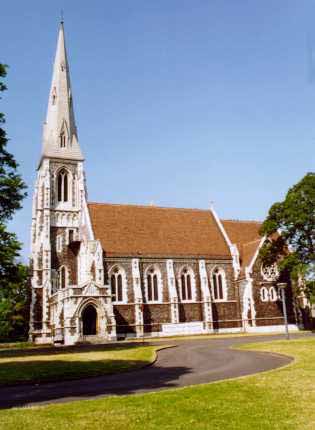
* St Albans Church (1885)
The English Church - The Patron is Queen Elizabeth II
The first Patron was Queen Alexandra (Wife of
Edward VII)
and now it is Queen Elizabeth ll who is the patron. A dispute debate
between the Russian ( 1881) and English churches for who was
allowed to have
the land for their church. Alexendra and Dagmar- 2 Danish
Princesses who both
became emporeseses. Alexandra was patron of St Albans Church
. Dagmar married
Alexander lll of Russia and was The last Tzars Mother
(Nicholas ll) . Dagmar was
buried at Roskilde Cathedral and was transferred to
(September 2006)
St Peter & Paul fortress in St Petersburg, Russia.
* ChurchillParken - Bust of Churchill / War resistance museum
(1940-45)
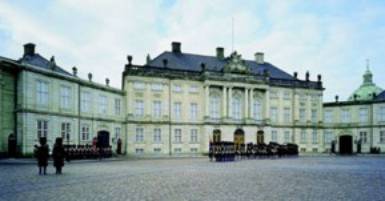
* Amalienborg P|alace
Photo Stop ( note, No parking at all allowed in square or else you will be
shot !)
* the 4 palaces - the Queens / Museum/ etc
- Built by Frederik V, in 1749
(changing the guard about 11.50-12.15)
* Marble church / Frederiks Church - worlds 4/5th largest
domed church started
designed by Nicolai Eigtved who died in 1754, The building
lay in semi ruin for
more than 100 years with costs too high etc Eventually
finished after 1874
* Statue on the horse is Frederik V
* New Opera House, tax deducted gift from A.P Moller - designed by Henning
Larsen costing approx 2.5 billion DKr. opened 15
January 2005
* Russian Church, Alexander Nevsky (Bredgade)
* Statue of Christian X on his horse
( Sct Anna Plads )
* Nyhavn ( best near Charlottenborg) Photo Stop
* Old sailors area / old red light district, Typical Flemmish
style warehouse buildings
* Hans Christian Andersen lived at 3 places in Nyhavn (number 20/67)and a couple
of
places around Magasin / Royal Theatre area
and often stayed at Hotel D'Angletterre.
* Kongens Nytorv ( Kings New Square )
* Amber Museum / French Embassy /Gothersgade original city center wall /
Hotel
D'Angletterre / End of Stroget (better quality
shops in city area) / Magasin / The
Royal Theatre (1748) built by Nicolas Eigtved
- The Danish Royal Ballet (1771)
(Rosenborg Slot via Gothersgade and Sølvgade etc)
* Christianshavn (optional depending on time)
Original photo : Paul H Wilson
Vor Frelsers Kirke ( Our Savious Church) 1696
* The Danish Foreign Ministery
* Orlogs/Navy Museum
* Our Saviours Church - 1696
Grundtvig was a Priest here for about 4 years writing many hymns
It costs 20 DKr to go right up to the top and is an exciting experience and
fantastic view point
* Christiana - 1971
* Strandgade - Christians Kirke - Rococo Church built in 1755-59
* New Opera House (note : have to drive all round by Klovermarken to visit
!)
Bank of Denmark - Designed by Arne Jacobsen
* Holmens Church-(1619) Navy Church and where the Queen was married (Christian
4)
* Borson 1624 ( old stock exchange) ( Christian 4 )
* Christiansborg- Danish Parliament
* Ministery buildings / Finance ministery etc
* National Museum
* Thorvalds Museum
* Prime Ministers office
* Jewish museum
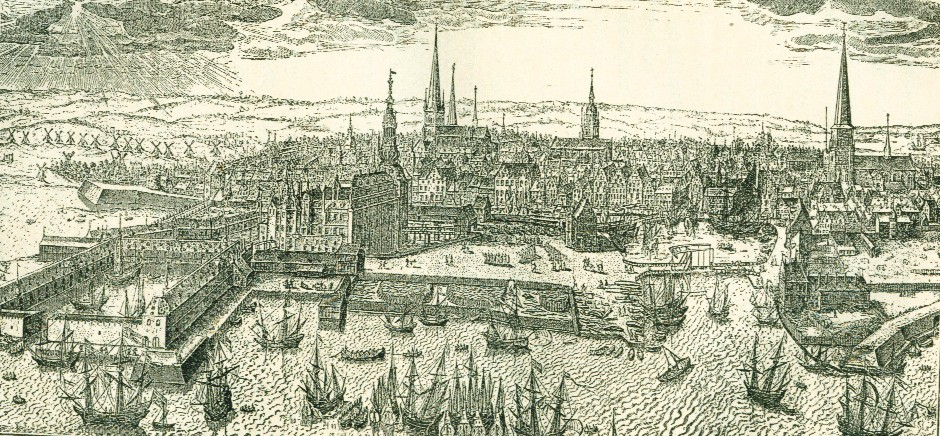
* Højbro Plads
Near Bishop Absalons statue (if
possible)
Photo stop
* Bishop Absalon - founded Copenhagen in 1167 ( Bishop
of Roskilde and Southern Sweden)
* Copenhagen means Merchants Harbour (HAFNIA in Latin)
(Købmagergade etc) Became the capital in 1416
* The area nearby and towards Holmens Kirke is the place where Copenhagen
started
* Underwater scupltures -
Stork Fountain
* Fisherwoman statue and fish stall
* Højbro plads - flower market in old days
* Walking Street / Illum etc
* Royal Copenhagen building 1775 / Georg Jensen / Holmegaard / Ilums Bolighus
* Kobermagade post office (actual true city center, streets all lead away
from here generally low
even numbers to the right etc etc)
Drive through city parallel with stroget (optional depending on time)
* via Magasin / Kongens Nytorv / Gothersgade / Store Regnegade /
Antonigade
Kronprincesgade
/ Over Kobemagergade
* Round Tower - ( 1642) (Christian 4) - observatory / 7 times
around in his carriage / exhibitions etc
* Grabrodre Torv -(3 major fires in the city, new buildings without corners as
then the long horse
drawn fire engines could get round the corners more easily. old buildings
before the fires with corners )
* Skindergade / Vestergade
* Gammel Torv / Nytorv - Byret etc - Fountain
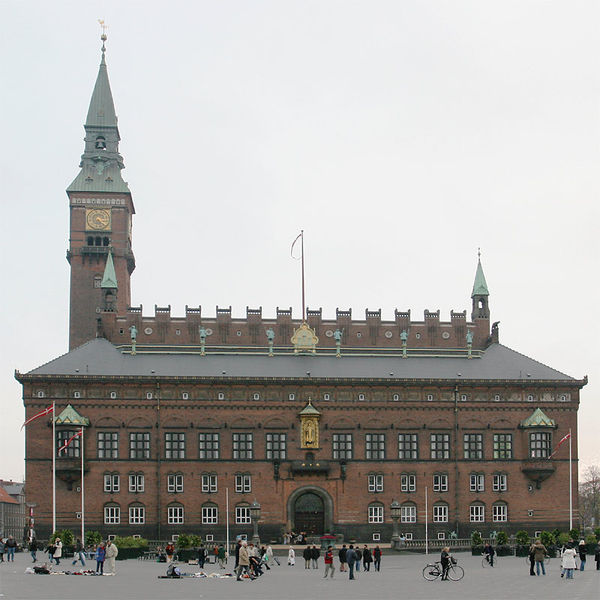
* Town Hall Square - Italian style 1905 (same
year as Norway became Independant ! )
106.5 meters high - Gold figure of Bishop Absalon above front door.
* Nye Carlsberg Glyptotek - Carlsberg Fund
* Tivoli Gardens - 161 years
Palace cinema - old Rail station and now one of the largest Cinemas in
Copenhagen
Royal Hotel - designed by Arne Jacobsen ( + The Egg & The Swan chairs )
Main Railstation - currency exchange with Forex
* Istedgade - Pornography was Denmarks third largest export business for a while
in the early 1970's
* Carlsberg Brewery
Photo Stop
* Elephants/swatiska-Indian symbol / Carl Jakobsen and family etc
Buildings about 1876/1888 ( check each ) pictures etc on building
wall high up of family
good artistic detail on Victorian brewery buildings.
* Fisktorvet - new buildings on Islands Brygge etc
* Black Diamond- Danish architects -Schmidt, Hammer & Lassen - 1999
* Nykredit / Nordea / Ministry buildings / Politi Torv
·
The lakes - man made defenses
Jarmers Plads
* Kommune Hospital - 1863 (ish)
* Botanic Gardens - Existing 4th garden was opened in 1874
* Statens Museum for Kunst (1896 + 1998)
* Rosenborg Slot - 1606 - Christian lV / Danish
Crown Jewels / Queens lifeguards. (recommended)
* Norreport Station (Top of the walking streets)
* Copenhagen Cathedral / University / Synagoge / Roundtower etc
other interesting sights if on a long tour
** Zoo / Frederiksberg Town hall / Frederiksberg Alle
* Assistens Kirkegard (HCA and other famous buried
there)
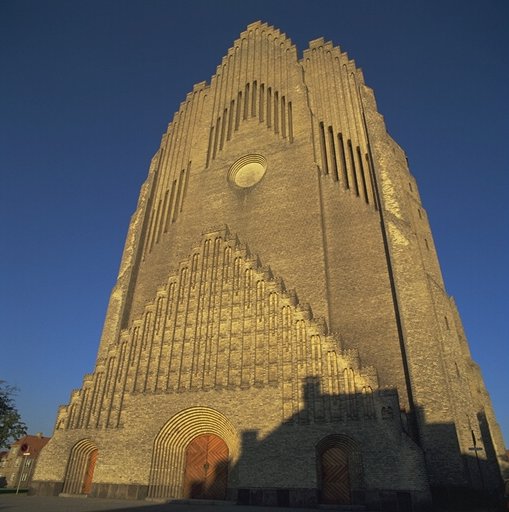
* Grundtvigs Church, Emdrup.
Peder Vilhelm Klint and
his son the architect/designer Kaare Klint and
his son Esben Klint built betwen 1921-1940 ( a
'Scandimodern' version of Roskilde Domkirke)
(Usually open between 09.00-16.00 - Sunday 12.00-16.00)
* Tuborg, Tuborg Bottle 1888 / WHO / Svanemollen Havn / Unicef
/ DFDS terminal / Langelinie
------------------------------------------------------------------------------------------------------------------------------------------
An excellent link to discover more information about the
street names
and history of Copenhagen City can be found on :
Absalon
---------------------------------------------------------------------------------------------------------------------------------------------------------------
ISAT Sightseeing Tours
Depart Copenhagen - Drive via Motorway to Roskilde C. (Approx population is 50,000)
Turn right after the Railway bridge just before City Center
Turn first left at the junction (before the roundabout - otherwise turn left at
the roudabout)
and then follow the signs for the Domkirke. Try to park in Main Market Square
(Roskilde Rådhus)
(alternative parking down the hill next to the Domkirke.)
Wednesday is market day. Be careful of any services held in
the Cathedral,
especially Sunday morning. Usual Opening hours
(1 April - 30 September = 09.00 -16.45 / Sunday& Holy Days
12.45-16.45)
(1 October - 31 March = 10.00 -15.45 / Monday closed / Sunday
& Holy Days 12.45-15.45 ) Cost 25 DKr.
Best to check on the Internet as there could be a Service / Wedding / funeral
etc.
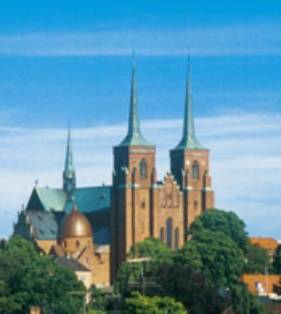
1)
(I usually go round Clockwise from the entrance)
A) Clock strikes on the hour - very old working clock from the late 15th century
B) Until 23 September 2006 'Dagmar' downstairs in Crypt
C) Note: Christian 4 - Born 1577, became king in 1588, died in 1648 plus the
large Mural (of him on board the ship in the battle) in his crypt - original
painting at Frederiksborg Slot.
D) Bishop Absalon - Founded Copenhagen in 1167 ) - Painting of all the Bishops
E) Margrethe l (The small boy Christopher is her brother 1363)
F) Alterpiece made in Antwerp in 1560 showing Easter Week
G) Harald Blutooth in the Pillar tomb (opposite Christopher)
H) Seats used by the Canons are able to stand and sit
/rest/lean on them during long services.
These are all individually carved and different. Approx from
1420 called 'Misericords' (Latin for compassion)
I) Note: that some are kings of Norway - and Southern Sweden etc.
J) In 1995 Roskilde Cathedral was added to the UNESCO World Heritage List.
K) Roskilde was the old Viking capital of Sjælland and
Bishop
Absalon was also the Bishop for
L) Originally a Catholic Church and then became protestant after the Reformation in about 1536.
M) Tomb of Christian lX / Tomb of Christian 4 / Paintings of
the Bishops / Tomb of Margrethe l /
Tomb of Fredrik V / Tomb of the Magi (plus
heights of famous Royal visitors on the pillar)
(Estimated time about 45-75 Minutes) ( Interesting Cathedral Museum upstairs but usually not available)
2) From the Cathedral Entrance, one way street to junction,
turn Right,
Drive down the hill , turn Right and at the Roundabout go into the to
View the Viking Center to see more about Viking ship building.
Exhibitions about preservering artifacts,
The way the land/sea has affected Danmark area for thousands of years.
Ropes, sail cloth . making money, blacksmith Building a Viking Ships etc.
In 2006 the Viking Ship (Havhingst = Sea Stallion) built here is sailing to Norway and
in 2007 to Ireland-
the first expiditions of this type for about 1000 years !
Enter Viking Ship museum.
(You may pay at entrance near Car Park or when
entering Museum building itself)
May - September 10.00-17.00 - Cost 80 DKr. / October - April 10.00-17.00 - Cost
50 DKr.
allow guests to walkabout by self as there is plenty of
information displayed.
Remember the Film (and toilets) (and shop etc)
(Estimated time about 45 - 90 minutes depending on customers interest etc.)
From The Viking Ship Museum, turn left at the roundabout, turn left at the next
and this is the main road from Roskilde to Hillerød and follow the signs
and chat about Politics, life in Denmark, The Tax system etc.
----------------------------------------------------------------------------------------------------------------------------------------------------------------
ISAT - Sightseeing Tour
I rate Frederiksborg Slot
as
''Probably the best thing to see in the whole of Denmark''
* Slotskroen - about 1700 one of the oldest buildings in the
town
A nice place for lunch, but can take 30-40 minutes to wait for
the food,
so it could be an idea to order the food before going into Frederiksborg
Slot
(Slotskroen is temporarily closed since 01.07.2007. possibly restarting
under new management )
(HUSK in Car Park: set parking disc or you could get a ticket ! )
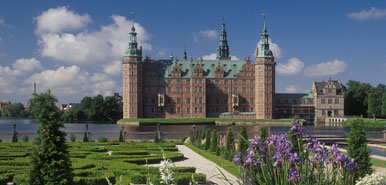
Land acquired by Frederik ll in 1560 bought from Herluf Trolle and his wiofe Birgitte Gøye
Christian lV was originally born at Hillerødsholm in 1577 and
in about 1600
he destroyed the mansion and started building Frederiksborg Slot
in the Dutch / French Renaissence style. Just before he died he was taken
from Frederiksborg Palace to Rosenborg Palace in 1648 .
Thee was a fire that badly destroyed part of the palace on 17
December 1859.
J. Carl Jacobsen ( Carlsberg Brewery) provided funds to restore the Palace
as it was and then
in 1878 he created the National History Museum in the Palace.
The Palace houses the best collection of Historical paintings in Denmark.
* Ringriderplads where Knights 'jousted' with a hoop dangled from the metalwork top span of the arch
* A nice place to take a picture of customers in front of the
fountain ( about 1617)
with the clock tower and palace in the background. The Swedes took
it as war booty in 1659 and it was returned in 1888.
* Note the C4 Above the arches
(Showing the Arabic numeral and not the Latin one after the Reformation in about
1534)
( Ladegaard with the Kirsten Munk seat 1628)
* The dragon drain pipes
* The metal work over the window (to the left in the inner
Palace Coutyard
and the wooden door to the Chapel, the detailed sculptures all around etc.
The clock tower
*Sightseeing driver has free entry , remember senior/child discounts etc.
* Toilets are also sensible to mention / large bags not allowed inside / photos without flash
-------------------------------------------------------------------------------------------
1) The Knights Room
2) upstairs to the chapel - 1617 - Converted 1693 to The
Knights Chapel - Order of the Elephant/Dannebrog
a) Shields of Poul Schlutter and Uffe Elleman Jensen
b The kings seat in the chapel
c) German made Compenius Organ - 1610 almost 400 years old (in
the Chapel since 1617)
d) Shields of the Danish royal Family ( Mary has replaced Alexandra in 2007)
e) Shield of Marsk Mckinley Møller (Mærsk symbol) & Niels Bohr
f) Shields og Churchill, Montgomery and Eisenhour
g) Shields of Many Royal families around the world
Britain, Scandinavia, Europe, Japan, Thailand etc, etc.
H) The ivories in the Kings praying room
( very Catholic in apperarance as it was in those days After
the Reformation about 1534 ish )
3 ) The Audience Room (untouched by the great fire)*The waiting room
*The Privy passage
* view the formal French Garden ( design on brochure)
* The hunting lodge and deer park( unable to see , but to the left in the trees
* Discreet meetings so as no one could listen
* The Chair elevator used (to surprise guests ?)
and also to go out of the castle
- a quick way in and out of the Palace for the King to go hunting etc.
4 ) The Big room ( Special Exhibition on Christian lV from
September 2006)
(2007 project -Copy of Royal Family tree for Sønderborg Slot )
Bishop Absalon - Large painting with King Valdamar I
Riders painting , style from about 1880-1910 - The model buildings etc
5) In historical Chronological order- The rooms reflect each
period with contempory paintings
( mostly dated) and furniture items. Note how the styles change as you go
further and how smaller items become more noticed, like Silver,
glass/crystal,
then porcelain from China, and then Meissen and then Royal Copenhagen etc, note
working the clocks.
Astronomy/astrology/navigation/sailing/exploration etc
*Note the style of clothes from the late ' Elizabethan period' etc
* ivory inlay with silver mounts on the tortoiseshell 17 th century cabinet ( turtle shell really !)
* Frederiki lll - Christian 4
*Christian lV Painting from Roskilde Cathedral,
*Ceiling with Gefion
* The miniatures - The Leonora Christina collection
Napoleon Miniatures /orders of Elephant & Dannebrog etc
* The Ceiling with the stars. note the markentry and parkentry and vivid colours
of the furniture.
6) Up the stairs to the Queens bed -
* Objects of virtue cabinets for displaying your new or special objects / early Chinese Porcelain
7) Big room and large painting of Copenhagen in 1660 -
(Frederik lll becomes the absolute monarch)
note Holmens Kirke and The Old Stock Exchange / Navigation/ships etc
8) The Great Hall
A) Note the disgusting paintings of Margrethe and Henrik !
B) Dagmar + Alexander lll + Young Nicholas ll
C) Alexandra + Edward Vll
menton two sisters, Danish princesses who both became Emporesses
and lived together at Hvidovre Hus, Klampenborg ( see it later ?)
Alexandra married Edward and he was Victorias eldest son and was king from 1901
-1911. Dagmar
escaped on a British War ship from the Crimea and returned to Danmark and lived
with Alexandra
until her death in 1928 - her body is to be moved from Roskilde Cathedral to
Peter & Paul Fortress in
St Petersburg on 23 September 2006.
D) Peter The Great of Russia visited the Palace in 1716 ( noted under the
painting of Edward Vll)
E) Disco/ music/band area !
F) On ceiling the 3 giant brass candlebra with hands
G) Picture carvings of the artisans on the ceilings, unusual of ordinary people
in those days
H) Animals and birds around the edge of the walls/ceiling
I) Christian X on his horse
return and go to the small Corner room to the left..........
''The toys for the boys room in which the girls like when they see what it
is..................''
The Gottorpske Sky globe - The almost 400 year old German made working
mechanical globe
of the stars, planets and zodiac systems !! ( listen to it ticking)
*Continue round and note the Kings bed / working clocks / silverware etc
Note the Small rooms with good light for the ladies to play
cards or to do their embroidery etc,
fire screens to stop them going red in the face etc, Ivory box on the table.
French style mirrors ?
Christian Vl in the Fair ground style display
Continue round through the Christian lX section
* Punch bowls
* Meissen Porcelain centre piece made up of different sections, very
intricate and detailed and big !!!
* Ivory ship made of bone by prisoners of war /(Denmark
was technically neutral but more on the side of
Napoleon and when the British captured prisoners they were put into prisons
where they
were allowed to use the bones from the meat to create ships etc which they
could then sell for pocket money.........)
* Hans Christian Andersen paintings when he was a young
man,
unusual as he is often seen as older in most.
* Søren Kirkegaard bronze sculpture
paintings of many famous Danes
Depending on time you may return to the first floor to see the
mid 1850-1900 section - The Danish-German wars etc.
note how the uniforms and style is very similar
to the US Civil War and the Union Army
Elevator down
Palace Water
Shop
toilets etc
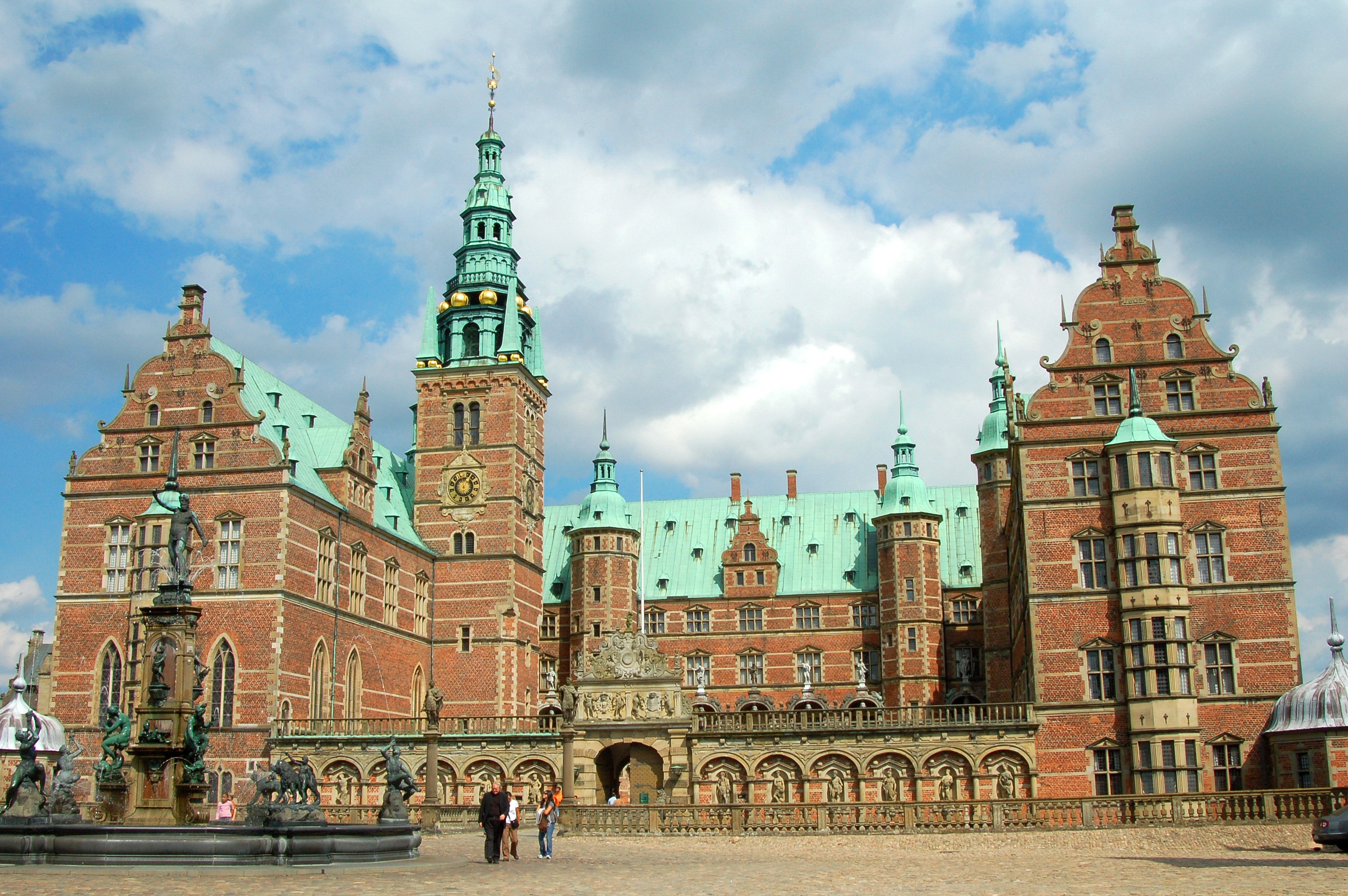
Frederiksborg Slot, Hilerød
The Photograph was kindly supplied
by Mr Robert G Elkins, Sightseeing Customer
from The USA - It shows the main entrance to the Palace with Mrs and Miss
Elkins
and myself next to the Fountain in the foreground.
* If time you may drive round to the top of the hill to take pictures overlooking the lake and Palace.
or...........
* Customers may walk through the formal French Gardens whilst you drive around
and meet them on the other side on top of the hill
Drive towards Fredensborg / Helsingor
Approx population of Hillerød is 30,000
Gribskov /Esrum Lake area is the second largest managed forest
in Denmark
(Stor Dyrehave -South of Hillerød)
----------------------------------------
Note the Jørn Utzon designed Arizona/Mexican style homes just after the
golf course
on the left and before the roundabout when arriving at Fredensborg
Fredensborg Palace (The Official Royal Summer Palace)
Originally a farm which was destroyed and the original palace was built about 1720-1726 in the
French Baroque style by Johan C Krieger for Frederik lV.
Further building work continued during the 18 th Century.
(George Bush Junior visited in 2005 - landing by helicopter in the
back garden)
Princess Isabella Christened in 2007 at Fredensborg Slotskirke
* Extensive gardens/park leading to Esrum Lake
*(Royal part of the Gardens are only open to the public during July)
*Nordmansdalen - Norwegian Valley - in the gardens
(approx 70 sculptures of Norwegian and Farose farmers and fishermen)
---------------------------------------------------------------------------------------------------------------------------------------------------------
ISAT - Sightseeing notes
Helsingør (Elsinore) (possible Origins go back 2000 years)
* First written notes about the city were from about 1231 in King Valdemars book.
* About 1200 St Olai's Church built.
* Town as we know it was founded in 1421 by Eric of Pomerania and started
collecting the 'Sound
Dues' in 1429 ( collecting of taxes for ships passing the
Sound)

* The first Castle built in about 1420.
* Extended in about 1577-1580 and named Kronborg by Frederik ll
* Famous as the setting for Shakespeare's Hamlet
* Special Note: Hamlet was written by William
Shakespeare in about 1600-1602 see seperate notes.
* Vital and important ferry link between Germany/Denmark and Sweden/Norway etc
* Population today approx 60.000 * Only town with a Casino on Sjælland (Casino Copenhagen on Amager)
After arriving in Helsingør it is an interesting idea to
drive via the old market square and show the
customers the traditional city center area, going past the Church and
Museum. Then make your way to
Kronborg - drive to The Swedish side of the Harbour and look out at Sweden, the
Ferries etc,
note Hamlet & Orphelia statues.
Park in one of the smaller bus spacesand enter the castle on foot.
Kronborg Slot
* One of only three sights in Denmark on the UNESCO World
Heritage Site List - Kronborg joined in 2000
* Go up the outer rampants on the left opposite the inner entrance to look at
Sweden, and the Castle etc
* Note the Lighthouse in the tower dated in the Christian lX period
* Note the green roof - it takes approx 25 years to weather from new to green.
* As one is entering betwen the Outer castle basement wall and the actual building, note the
Shakespeare plaque on the wall
* and the Kings Bedroom above the entrance
------------------------------------------------------------------------------------------------------------------------------
* Open : May - September 10.30-17.00 / October : Tuesday-Sunday 11.00-16.00
November - March 11.00-15.00
Cost : Ticket 1 ( 1+2+3*+4+5) = 75 DKr.
Ticket 2 (1+2+3*+4) = 60 DKr.
Ticket 3 (2+3*+4) = 30 DKr.
Ticket 4 ( 5) = 40 DKr.
1) Royal apartments - The most interesting part to visit
2) Basements - (dark and scary)- see Holger Danske and where the Army conscripts had to live
3) Tower roof - * Free (look at sunspots etc through the Telescopes of the Danish Astronomy Society if they are there)
4) The Chapel
5) The Maritime Museum
-------------------------------------------------------------------------------------------------
* Great fire on 25 September 1629
* Swedish bombardment during September 1658 - took the castle
* Christian V extended the defences and it became a military castle and not a
Royal Palace
* Military finally departed in 1923 and it was then reverted back to the style
of Fredrik ll & Christian lV
* When the Royal Yacht Dannebrog sails past the canons fire a salute.
* Holger Danske
* Royal Tapestries - 7 famous 'Goblin' tapestries ( the other 7 are in the
National Museum)
originally 40 were made by Hans Kneiper from Antwerp and commissioned by Federik
ll
* Frederik ll 's Bordhimmel
* Trumpet tower is approx 59 meters high (62 meters above the sea)
* Largest Ballroom/Dining room in Northern Europe at 62 meters long.
--------------------------------------------------------------------------------------------------------------------------------------------------------
ISAT -Sightseeing Notes
Southern Sweden Tour
Malmo & Lund / Around the Øresund
Notes regarding The Sweden Tour
------------------------------------------------------------------------
Øresundbroen
between Copenhagen and Malmo
* 1 July 2000 - approx 16 km long (10 miles)
* 4 km tunnel with 4 km man made island and 8 km of bridge
* the Pylons are 204 meters above the sea - (The world's
longest cable-stayed bridge)
-------------------------------------------------------------------------------------------
Sweden - Population approx 9 Million
Third largest country in Europe
forests cover about 53 % of the country
Lakes about 9 % of the country
1574 km North to South - 499 km East to West
-------------------------------------------------------------------------------------------
The Treaty of Roskilde in 1658 ceded the Southern provinces of Skane, Blekinge and Halland .
-------------------------------------------------------------------------------------------
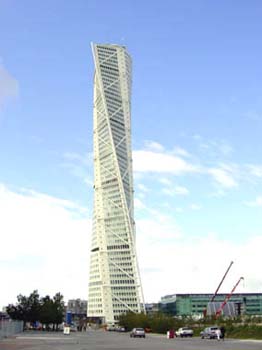
Second tallest apartment building in Europe / highest in Scandinavia.
190 meters high - 54 floors high - 9 Cubes twisted
147 flats - 10 floors of offices - Meeting / restaurant / party facilities at the top
(only for residents )
* Concrete foundation is 30 meters diameter x 7 meters thick
850 lorry loads
of concrete. taking 3 days todo plus being careful to keep it cool so as to prevent cracking etc.
Designed
with environmental issues in mind , energy saving etc.
------------------------------------------------------
Malmo City.
---------------------------------------------------------------
* Stortorget - 1536.
* Statue of King Carl Gustav X
(Took Skane region from Denmark in 1658.)
* Kockska hus - 16 th century ( acclaimed restaurant)
* Malmo City Hall - 1546 (redesigned 1860's - Dutch Renaissence style)
* The Reidence - 1850's - County Governors home. (Renaissence style)
* Hotel Kramer - 1870's - French Renaissence Style
* Apoteket Lejonet Pharmacy - 1890's - German Renaissence style
** Behind the City Hall is St Petri Church -
14 th Century and the oldest building in Malmo
** Ostergatan street St Getrude block - old restored medieval trading
centre and named after a former Chapel.
Lillatorget - 1592 - old market square
* Gamla Vaster street
Gustav Adolf's Torg - (King Gustav lV - 19 th Century)
Folkets Park - 1893
Malmohus Castle - 1436 (Eric of Pomerania)
Christian lll of Denmark built a new castle in 1542
became Swedish in 1658 - used as a prison from 18th Century until 1914
restored in 1920 - Museum since 1937
Comandants House 18 th Century
(initially the cavalary used it to store textiles later a hospital, barracks and residence)
City Library (Slottsparken)
The older section from 1899
The newer section from 1997 by Danish Designer Henning Larsen
Slottsmoollan ( Dutch Windmill ) 1891
------------------------------------------------------------------------------
Lund
- founded by King Canute - 1020approx 120,000 Population - approx 40,000 Students
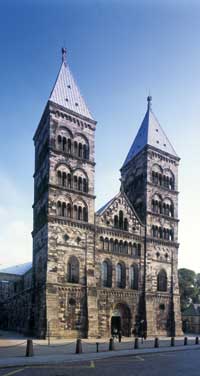
Lund Cathedral
- Started in 1080 - crypt consecrated by the first Archbishop Ascer in 1123
* Consecrated in 1145-
* Bishop Absalon (Roskilde)
* Style - Nordic Romansque Architecture
* 'Finn the Giant' guards the crypt ( on the pillar)
* 'Horologium Mirabil Lundenese (Working time and dating machine - 1424)
* The Alter from 1398
* Lund University - 1660
* Second oldest in Sweden
* largest in Scandinavia
* Swedification of region was the primary reason for the University
starting. before, there had been a Studum Generale for training
Franciscan monks and the Franciscan Friary of 1438- this was the first
instution of higher education in Scandinavia
* 4 Charters
A) The Deed of Incorporation
B) The Donation Charter
C) The Letters Charter
D) The Constitution Charter
* The University was known as ''Academia Carolina''
* Epithet was 'Conciliatrix ' (Reconcialiation between Sweden and The New Provinces formerly owned by Denmark)
* The original Faculties were : Theology, Law, Medicine and Philosophy
Museums and buildings around The University / Cathedral /
Lundgård Park (Clockwise from the Cathedral / Tourist office).
* The four sphinxes on top of the Vice Chancellors building - representing the 4
original faculties.
* The University Quadrangle with fountain.
* The Kings House (Lundagårdshus) Built by Frederik ll of
Denmark
* Museum and Archive of the Academic Society
* Lund University Museum ( behind above - over the road)
* Kulturen-30 historical buildings with 16 permanent exhibitions (the Swedish
museum of the year in 2004).(across the road)
* The Historical Museum
* The Cathedral Museum opposite acros the road
-------------------------------------------------------------------------------------------
From Lund, drive towards Lanskrona on the motorway
-------------------------------------------------------------------------------------------
Landskrona
- Population approx 30,000------------------------------------------------------------------------------------------
At junction 26 (Landskrona North) Drive towards Borstahusen
and you may take lunch at Erikstorps Restaurant (+46 ) 0418-260 75
-----------------------------------------------------------------------------------------
Helsingborg
- Population approx 100,000-----------------------------------------------------------------------------------------
a) Drive to The Rear of Kronborg Slot and see Sweden etc and Hamlet and Orphelia etc, then park
vehicle and go into Kronborg Slot.
b) Drive quickly into the market Square and look at the buildings / shopping
area etc, past the Church
and Museum and go to (Kronborg or Stranvejen /Fredensborg ?)
------------------------------------------------------------------------------------------
Helsingør - Kronborg Slot - see seperate notes
------------------------------------------------------------------------------------------------------------------------
ISAT - Extra Knowledge Course - Extra Notes
Bishop Absalon - Bishop of Roskilde
Born 1128 - at Søro
died 1201 ( buried at Søro)
( part of the oldest lived in
property in Denmark)
Archbishop of Lund 1178-1201
served as a chief counsel for King Valdamar 1 / King Canute Vl
succesful Battles over Rugen and Pomerania
Founded Copenhagen in 1167 ( Merchants Harbour / Hafnia in
Latin)
(Copenhagen became the capital in 1416 )
-------------------------------------------------------------------------------------------
Christian IV
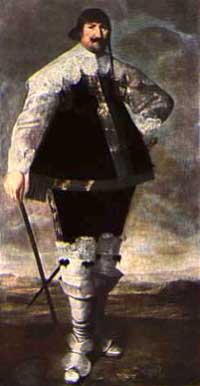
Born in 1577 at Hillerødsholm (Frederiksborg Slot)
Father Frederik ll - mother Queen Sophie of Mecklenburg
Became King of Denmark, Norway & Southern Sweden in 1588 - Coronation in
1596
died in 1648 at Rosenborg Slot - buried at Roskilde Cathedral
son became Frederik lll
Was responsible for building :
Rosenborg Slot - 1606
Christien died at Rosenbog Slot
Holmens Kirke - 1617-19
Navy Church where the Queen was married
Børsen old Stock Exchange) 1619-41
Trinitatis (University Church) next to the Round Tower
The Roundtower built 1637-1642 & 36 meters high / visited by Peter the Great
in 1716
& Regensen (College Dorm opposite The Round Tower for 100 students)
Nyboder 1621 -
Nyboder was originally built for navy sailors and is still used primarily for
this purpose today
Frederiksborg Slot 1602-1622
(previously inherited in 1560 by Frederik ll and known as Hillerødsholm .
Christian born there )
Ripped the building down in about 1600 and started developing
Frederiksborg Slot over the next years. Great fire in 1859 which was restored
afterwards.
Proviantgården 1598 ? / Tøjhuset Museum -1604 ( over from Christiansborg)
Christianshavn 1618-1623 - fortified the swampy area
Christianstad 1614 - (Kristianstad, Sweden)
Christiansand - received town status in 1642 / West coast of Norway
rebuilt Oslo and called it Christiana
help found The Danish East India Company (ØK)
Kalmar War 1611-1613
Involved in the 30 years war
Fairly successful in war making in the early years but later suffered defeats
Wife 1 = Anne Catherine of Brandenburg died in 1612 - 6 children
Misstress =Kirsten Madsdatter -1 child
Misstress = Karen Andersdatter - 3+ children
Wife 2 - married in
1615 = Kirsten Munk (1598-1558)
12 children ( Leonora Christina being
one of these)
Misstress = Vibeke Kruse - 2 children
he had at least 23-26 children...........or more............
--------------------------------------------------------------------------------------------
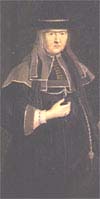
Ludvig Munk of Nørlund, died 8
April 1602 at Lundegaard, buried at Nørrebro church,
married 29 June 1589 at Copenhagen to Ellen Jørgensdatter Marsvin of
Lundegaard
(born 1 February 1572 at Landskrone Slot, died 11 November 1644?, buried at
Odense).
--------------------------------------------------------------------------------------------
Kirsten Munk
(1598-1658)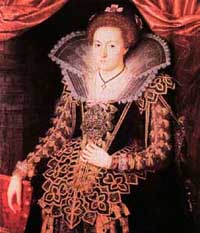
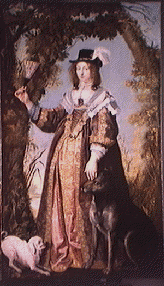
* Born 8 July 1621 at Frederiksborg Slot
* Father : Christian lV 1577 - 1648 (Crypt at
Roskilde Cathedral)
* Mother : Kirsten Munk 1598 - 1658 ( unknown grave in Odense)
* Married in 1636 to Corfitz Ulfeldt
(Steward of the Realm - lived in Løvstræde-Gråbrodretorv)
&
* Not liked by Fredrik lll 's wife Sophie Amelia and they went
to live in Sweden in 1651

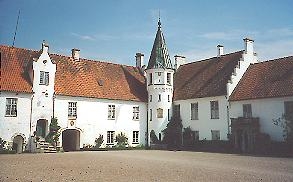
Ulfeldt's Home in Sweden - Bosjokloster, Skane
* Ulfeldt was imprisoned in Sweden in 1659 and later she was
arrested and both were
imprisoned at Hammershus Castle on Bornholm in 1660-1661
* She went to England to try to recover some loans made to
King Charles ll
by her husband, but was arrested in 1663 and handed back to Denmark
and for the next 22 years she was imprisoned without charges in
The Blue Tower at Copenhagen Castle (Christiansborg)
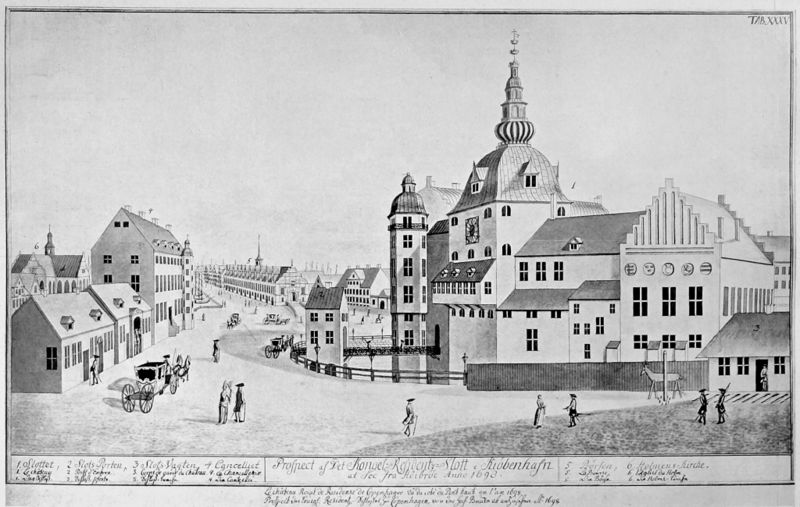
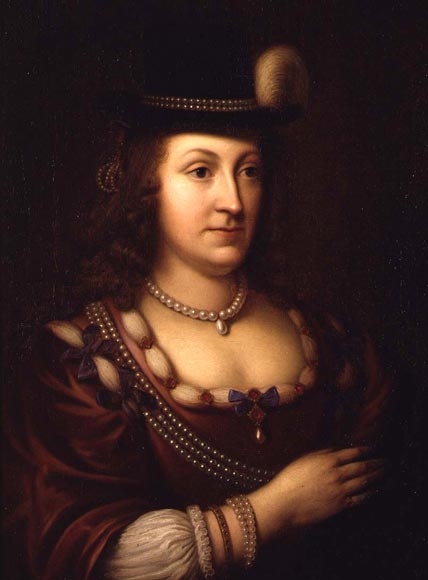
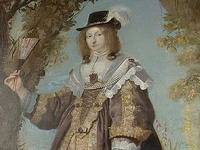
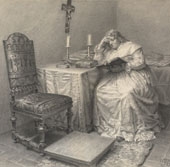
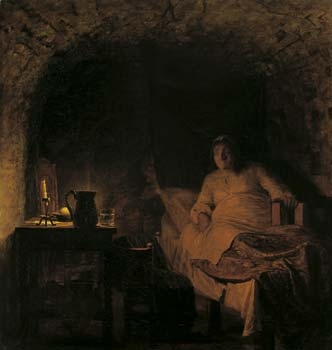
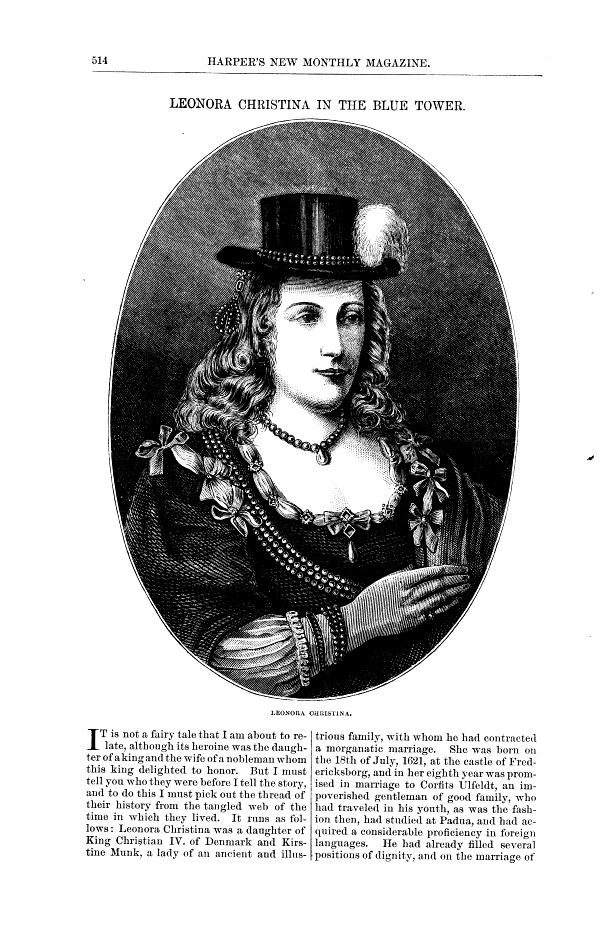
* She wrote her famous autobiography '' Jammersminde''
( A
Memory of Lament / woe )
whilst in The Blue Tower - ( which was first published in 1869)
* Wrote Heltinders Pryd (Praise of Heriones) in 1689
* After the death of Sophie Amalia in 1685 she was released
and
spent her last years at The Nobleladies Kloster Maribo, Lolland..
* She died at Maribo Kloster on 16 March 1698
and is buried at Maribo Cathedral .
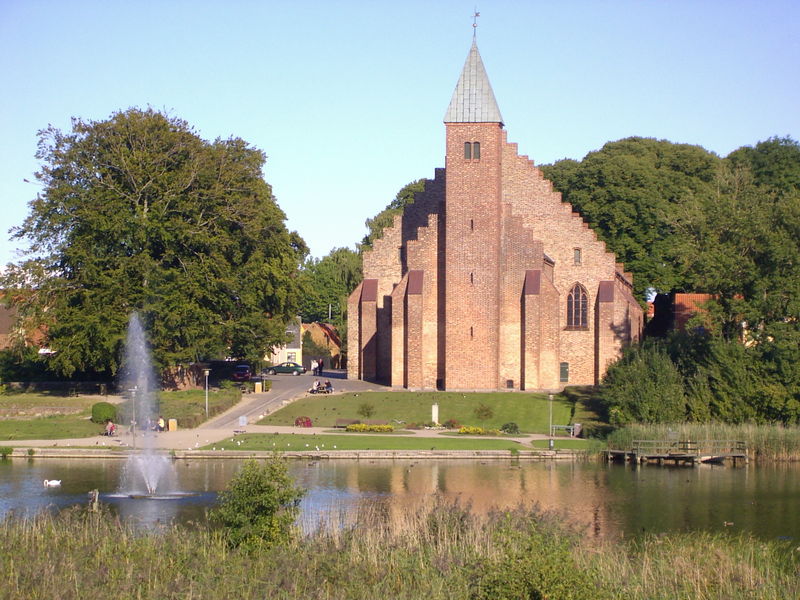
----------------------------------------------------------------------------------------------------------------------------
ISAT - Extras notes for the Advanced Course
Hamlet - Prince of Denmark
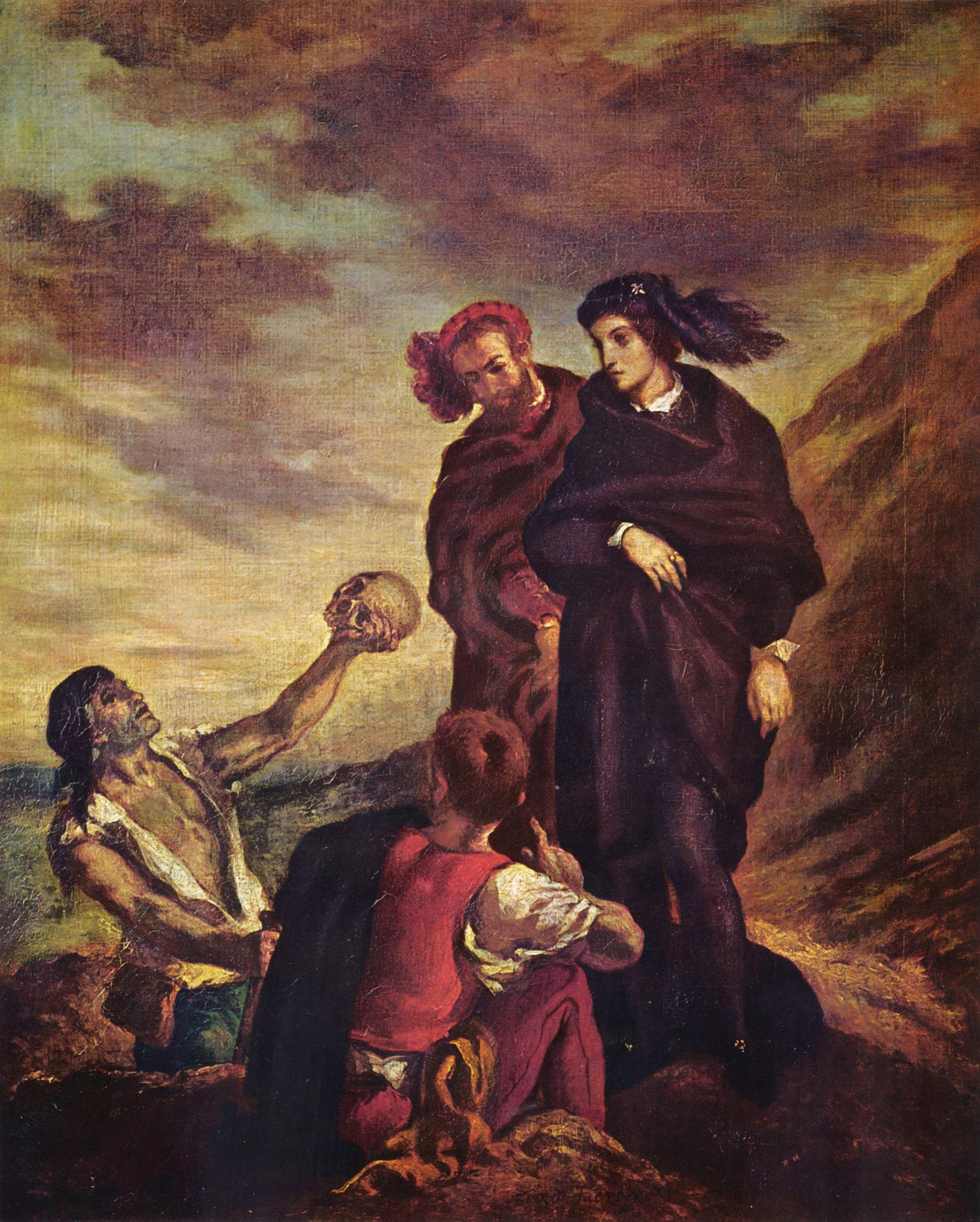
Hamlet & Horatio in the Cemetary
By Eugene Delacoix
Hamlet was written about 1600-1602
By
William Shakespeare (1564- 1616)
To be , or not to be................
that is the question..............
The story is about the revenge of Hamlet over his father who
was the the victor over the Polish army.
His father the King died suddenly , biten by a snake and the
King's brother Claudius had been
appointed the King and married his brothers widow Queen Gertrude .
The play commences on the battlements of Kronborg where a
ghost appears before Horatio
(A friend of Hamlet) and the soldiers on guard. The ghost vanishes without
speaking.
The next day the Court assembles to celebrate the marriage of
Claudius and Gertrude -
Hamlet is not happy about it. Horatio informs him about the ghost.
That night , Hamlet and Horatio await with the soldiers for the appearance
of the Ghost.
The Ghost informs Hamlet that his father was murdered by Caudius and the ghost
urges
Hamlet to avenge him. Hamlet swears Horatio and the soldiers to secrecy
about the ghost.
Hamlet is not certain if the ghost is his father or the devil
out to trick him, so he tries
to test to see if Claudius is guilty - so he pretends to be mad
Arranges a play to be performed based on the death of his father. Hamlet notes Claudius's guilty reaction.
Hamlet confronts his mother and Polonius the kings chief
Advisor who happens to have
a daughter Orphelia whom Hamlet loves, is hiding behind a tapestry Hamlet kills
him thinking it might be Claudius.
The ghost appears and Hamlet talks to it but the queen really thinks Hamlet mad as she can not see it.
Hamlet is sent to England by the King and intended to have him
murdered but Hamlet
is aware of the plot. Orphelia actually does go mad because of her
father's
death and Hamlet being sent away and dies .
Hamlet returns in time and in shock to see the start of
the funeral, fights Laertes (Orphelia's brother)
at the graveside as Claudius has arranged it, meets the skull of Yorick
(an old jester of the Court)
Gertrude 'accidently' drinks poison that was meant for Hamlet provided by
Claudius.
Laertes sword was already poisoned and Hamlet was hit by this.
However Hamlet captured Laertes sword and killed him with the the poisoned
sword.
Whilst mortally wounded Hamlet kills Claudius with the
poisoned sword .
Horatio is prevented from comitting suicide by Hamlet who wants him alive to
tell the story to the world.
The Norwegian Prince Fortinbras and the English Ambassadors arrive to see
the terrible events
and Hamlet names Fortinbras as the next King as he dies . Horatio tells
Fortinbras and
the English Ambassadors the whole tragic story .
''There is something rotten in the State of Denmark''
------------------------------------------------------------------------------------------------------------------------------------------------------------------
ISAT - Extra notes

The Little Mermaid by Hans Christian Andersen (1805 - 1875)
23 August 1913 - Sculptured by Edward Eriksen / commissioned by Carl
Jacobsen
Story of a young mermaid who saves a prince from drowning when
his ship sinks.
They fall in love. But a mermaid can not live on land in the air and he can not
live
in the sea under the water. So they did not live happily ever after
together !
-------------------------------------------------------------------------------------------
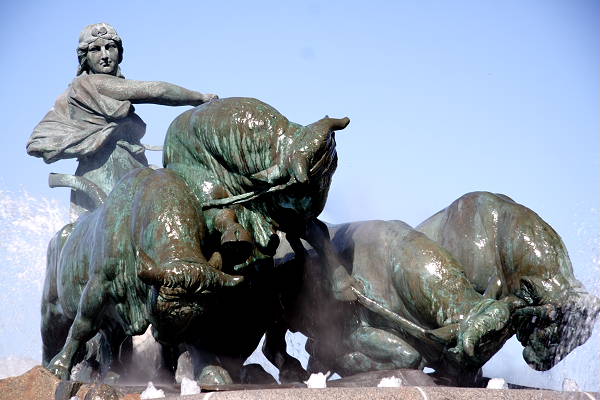
Gefion
Gefion creates the Island of Zealand
From The Prose Edda of Snorri Sturluson
King Gylfi ruled the lands that are now called Sweden. It is
told of him that he gave a plough
land in his kingdom, the size four oxen could plough in a day and a night, to a
beggar-woman
as a reward for the way she had entertained him. This woman, however, was
of the family
of the Æsir. Her name was Gefion. From the north of Giantland she took four
oxen and
yoked them to a plough, but those were her sons by a giant. The plough went in
so hard
and deep that it loosened the land and the oxen dragged it westwards into
the sea, stopping
in a certain sound. There Gefion set the land for good and gave it a name,
calling it Zealand.
But the place where the land had been torn up was afterwards a
lake. It is now known in
Sweden as "The Lake." And there are as many bays in "The
Lake" as there are headlands in Zealand.
As the poet Bragi the Old says:
Gefion dragged with laughter
from Gylfi liberal prince
What made Denmark larger,
so that beasts of draught
the oxen reeked with sweat;
four heads they had, eight eyes to boot
who went before broad island-pasture
ripped away as loot.
The other legends suggests that Gefion was envious that her
brother had received some land
from the King of Sweden ( the island of Fyn) and she also wanted some land and the king said you can
have
as much as you can plough out in a single day, she had 4 sons with the king of
Norway who
she turned into bullocks and so she ploughed out of the land of Southern Sweden
(Lake Vanern)
the island of Sjælland. The Swedes have a similar tale regarding the
island of Gotland (Lake Vattern).
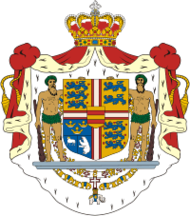

Christian lX was known as the 'grandfather of Europe
whilst
Queen Victoria was known as the 'Grandmother'
------------------------------------------------------------------------------------
House of Oldenburg (Glucksburg branch)
Queen of Denmark, Greenland & Faroe Islands
Dronning Margrethe ll 1940 -
Prince Henrik (French) 1934 -
Crown Prince Frederik 1968 - and his wife Mary (from Tasmania, Australia)
Who have a son, Christian and Daughter, Isabella.
Prince Joachim 1969 - his ex-wife Alexandra (fromHongKong)
Who have two children. Alexandra has re-married in 2007
Late father, King Frederik lX 1899 - 1972 - Buried at Roskilde
Cathedral - outside
Late mother, Dronning Ingrid (Swedish)1910 - 2000 - Buried at Roskilde Cathedral
- outside
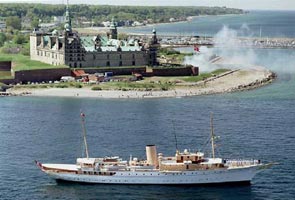
Every time The Royal Yacht
Dannebrog passes
Kronborg the Cannons fire a salute.
These notes are Printed and published by Paul H Wilson 2006
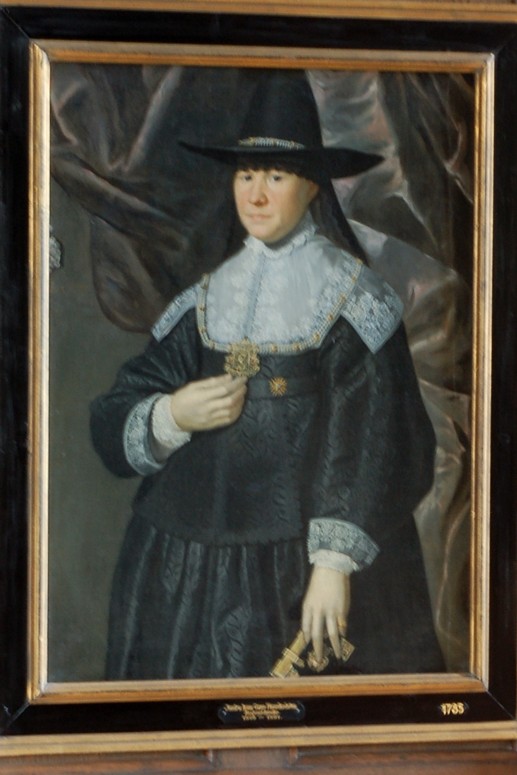
Anne Gøye (1609 - 1681)
Gøye, Anne
1609-81, bogsamler.
*18.12.1609 på Turebyholm, Tureby, sg., †9.1.1681 på Hvedholm, Horne sg.
Forældre: godsejer Henrik G. (1562-1611) og Birgitte Brahe (1579-1619).
AG blev født på Turebygård, det nuværende Turebyholm, som det niende og næstyngste barn. Efter faderens død i Kalmarkrigen 1611 blev hun og hendes fem søstre hos moderen, mens de fire brødre kom i huset hos mosteren Sophie Brahe og hendes mand, den lærde ◊Holger Rosenkrantz på Rosenholm. Da moderen døde i 1619, kom pigerne ligeledes til Rosenholm, hvor AG boede frem til 1627, mens søsteren ◊Mette G. blev der lige til onklens død i 1642. Efter et kort ophold på Brandholm hos broderen Eskil G. flyttede AG i 1628 til en anden af sine brødre ◊Falk G., der ved sit ægteskab samme år med Karen Bille var kommet i besiddelse af Hvidkilde på Fyn. Her oplevede familien en stor tragedie, idet lillesøsteren Sibylle G. blev dømt og henrettet for at have født i dølgsmål og ombragt barnet. Henrettelsen fandt sted i Odense i 1635 i overværelse af ◊Christian 4. I 1649 blev Falk G. udnævnt til hofmester ved Sorø Akademi, og AG fulgte med ham og svigerinden til Sorø. Da han døde i1653, flyttede hun og Karen Bille tilbage til Hvidkilde. Under Svenskekrigen blev de i 1657 fordrevet og måtte tage ophold hos Karen Billes datter Susanne G. og hendes mand ◊Preben Brahe. Falk G. havde ved sin død efterladt et økonomisk kaos, som AG forsøgte at redde svigerinden ud af, hvorved hun bl.a. fik halvpart i Hvidkilde, indtil godset blev solgt 1679.
Efter fredsslutningen 1660 flyttede AG til Næstved, hvor hun havde ejendom i arv efter sin moder, og her tilbragte hun de næste knap 14 år med såvel litterære som praktiske sysler. I et forord takkede ◊Peder Syv, der i disse år var rektor ved latinskolen, hende for tilladelse til at benytte hendes private bibliotek, og hun forsøgte at få en lokal præsts skrifter udgivet som støtte for hans enke. Sine sidste år tilbragte AG på opfordring fra Susanne G. i familiens ejendom, den gamle bispegård i Odense. Hun døde under et besøg hos familien på Hvedholm. Den litterære interesse havde hun arvet fra sin moder, der gav hende den første bog 1613 og ved sin død efterlod hende sine bøger, og den blev forstærket gennem tiden på Rosenholm. Ved arv, gaver og indkøb oparbejdede hun en stor bogsamling, som hun kort før sin død overdrog til Susanne G.s datter ◊Karen Brahe for at sikre dens bevarelse for eftertiden. Ifølge et håndskrevet katalog, udarbejdet ca. 1686 af den senere biskop ◊Jens Bircherod, bestod samlingen af 1.116 bind, heraf 76 håndskrifter. Den indeholder fortrinsvis dansk teologisk litteratur og enkelte tyske og svenske bøger, men også brugsbøger og skønlitteratur, heriblandt svigerinden ◊Birgitte Thotts skrifter og folkevisesamlingen Karen Brahes Folio.
Mal. fra 1641 på Fr.borgmus. Mal. fra 1647 i Odense Kloster.
Optaget i Dansk Biografisk Leksikon.Susanne Lykke Vølzgen Nielsen
temporary notes - to be created / translated soon
------------------------------------------------------------------------------------------------------------------------------------------------------------------------------------------------------------------
"Maren splid"..
Here story goes on abit Earlier,more precisely in the year of 1636 where it took its beginning.
This Year a Taylor-(Witch name where "Didrik Hermann") from a town called "Ribe",caught a disease ,and had great pains,and sudden spasm-attacks..One day he had a really bad attack,and he threw up alot of Black fluid.. Hes wife and other woman's,witch also where present when the accident accurd,all meant that it couldn´t be natural..so they called for some men to investigate the Black fluid/The puke,and these men told it to the court..When the man that should tell about it to the court arrived,he told that one night he had seen that there had been 3.woman's in the chamber/Room,and he was of the opinion that one of them where o local woman named"Maren splid",or perhaps it was the Devil in her disguise,he also told that there had been 2.persons holding him,and then Maren had blew from her lips,down his throat.. The next day at court he told that he had, had an argument with Maren Splid,and that she had ended the disagreement with promising sickness and bad luck to him.. It took very long time for the locals to understand what Maren was accused for ,because she was very well seen at among the locals,and she had high standard,and was highly respected among woman's of the town Ribe,but once they did,there where alot of accusations against Maren,course she was of really bad temper,and therefor she had promised many bad things against many different persons in the town..Her husband(Marens) where also a taylor,and also owned the local Tavern,so when people had,had abit to much too drink,Maren Splid where the one to threw them out..
Once there had been a Corporal in the tavern..Also he had,had abit to much to drink,and started a argument with Marens Husband by throwing a beer can after him..Maren had gotten angry,and promised the Corporal many Evil and bad days..
All in all the trial against Maren Splid was very long,infact it lasted for 4.years,where Maren defended herself good. But the Danish king at that time –the king "Christian the 4",was a dedicated witch-hunter that also followed the case as it developed. At the first trial,people wasn´t sure if Maren Splid had received torture,but at the second,she definitely did..The meaning of the torture was ofcourse to make Maren confess witch she did at the end. She was put to the stake and burned as a witch on the 10´th November 1641,on"Galgebakken" just outside of ribe..The confessions Maren made where as follows:
In 1641,the 10´th of October in the blue tower(Blaataarn),;Maren Splid from the town "Ribe" Confessing the following:She confessed that within the last 14.days, a man named andreas had come to here in the shape of a red dog,it entered her room and told here to confess
She also confessed that when she went to Altar at the local church,then she took the bread and hid it in here clothes,until she could throw it under the chair where she sat,and then she stepped and spit on it.
for the third she confessed that she,together with her companions ,gathered 3.times every Year,at:Walpurgis night,at:Sanct.Hans(Devils night),and: Michaels-day..
Sometimes they met at here own house,and sometimes at "Anna Gielderup"s house,where they did their doings.
Finally she confessed that they had met on "Fardrup Cemetery",and there they had danced and held a party..where also Andreas had appeared sometimes as a dog,sometimes as a human.
You now have read the short story of Maren Splid
*
When this page is updated I will tell you some more about serious accusations of Witchcraft,and also some more information about how it was seen and dealed with by the Terrible priest-hood and so called "Keepers of the faith of light and life",I will also go more into the Symbolical Acts the Witches did,and how people that denied Christianity and" God",could make symbolical acts as a opposite to the Christians doing their rituals..How the Witches and their Hunters Fought eatchother in a spiritual way,both sacrificing and worshipping to each of their own powers and demons/Angels. But that's all for later,so lets finish of with some typical accusations of woman that the priesthood thought belonged to the fire..First perhaps you should know that:-90% of the accused Witches in Denmark were Woman-
-2/3 out of these where over 50 years old-
-Most of them where married-Actually up to 59%-
A witch could steal the"Butter-joy",so that there when the creamed had been whipped,there would still not appear butter..
She was also accused of"Long-distances milking" of cows and sheeps,so that there was nothing left when the farmer started milking in the morning..She did this by taking a sharp knife or likewise and set it into a wooden stake,and then milk the knife while she spoke out the name of the person who milk she wanted.. Witches where accused of drinking from the beer –tank,while demon-helpers stood behind the witch and tapping liquid from the witches behind,then finally when there where no more in the tank-she and here helpers put the urine into the tank,for the humans to drink.. These accusations where stupid and empty for the most time,as the Witch-hunt grew to everyones heads,woman in the 16´th century,were accused for being a witch very easiely,and for sure the Priest-hoods,destroyed more Christians and stupid Wiccas (Witch arent so bad at all) than real Witches.----------------------------------------------------------------------------------------------------------------------------------------------------------------------------------------------------------------------
Two famous British naval victories over Denmark at the
battles of Copenhagen in 1801 and 1807
-----------------------------------------------------------------------------------------------------------------------------------------------------------------
The Battle of Copenhagen
2 April 1801
The Battle of Copenhagen, 2 April 1801:
Vice Admiral Lord Nelson's official report to Admiral Sir Hyde Parker
Elephant, off Copenhagen, 3rd April 1801.
Sir,
In obedience to your directions to report the proceedings of the Squadron which you did em the honour to place under my command, I beg leave to inform you that having, by the assistance of that able Officer Captain Riou and the unremitting exertions of Captain Brisbane and the Masters of the Amazon and Cruizer in particular, buoyed the Channel of the Outer Deep and the position of the Middle Ground, the Squadron passed in safety and anchored off Draco the evening of the 1st.
Yesterday morning I made the signal for the Squadron to weigh and to engage the Danish line, consisting of six sail of the Line, eleven floating batteries, mounting from twenty-six twenty-four pounders to eighteen eighteen pounders and one Bomb-ship, besides Schooner Gun-Vessels. These were supported by the Crown Islands mounting eight-eight cannon and four Sail of the Line moored in the Harbour's mouth and some batteries on the Island of Amak.
The Bomb-ship and Schooner Gun-Vessels made their escape. The other seventeen sail are sunk, burnt, or taken, being the whole of the Danish line to the southward of the Crown Islands, after a battle of four hours.
From the very intricate navigation the Bellona and Russell unfortunately grounded but although not in the situation assigned them yet so placed to be of great service. The Agamemnon could not weather the shoal of the Middle Ground and was obliged to anchor but not the smallest blame can be attached to Captain Fancourt: it was an event to which all the Ships were liable.
The Action began at five minutes past ten - the Van led by Captain George Murray of the Edgar who set a noble example of intrepidity which was well followed up by every Captain, Officer and Man of the Squadron. I beg leave to express how much I feel indebted to every Captain, Officer and Man for their zeal and distinguished bravery on this occasion.
The loss in such a battle has naturally been very heavy. Amongst many other brave officers I have with sorrow to place the names of the gallant and good Captain Riou and Captain Moss of the Monarch who has left a wife and six children to lament his loss.
I have the honour to be, Sir,
Your most obedient Servant,
Nelson & Bronte
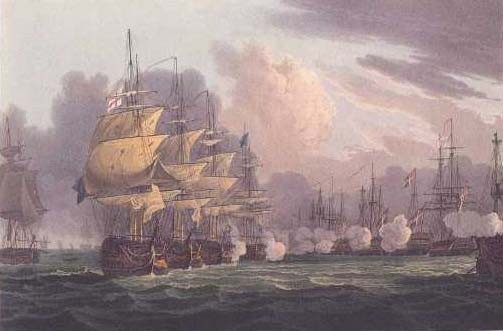
The Battle of Copenhagen - 2 April 1801
This is the battle in which the famous incident of Lord Nelson
putting his telescope to his blind eye occured.
One of the British ships was called HMS Glatton
and was captained by a certain William Bligh..............Of the famous Mutiny
of the Bounty ! ---------------------------------------------------------------------------------------------------------------------------
Second Battle of Copenhagen 1807
British Bombardment of Copenhagen and the surrender
of the City and Danish fleet on 7 September 1807
Admiral Lord Nelson had died at the
Battle of Trafalgar in 1805 and it was
Admiral James Gambier who led the attack on Copenhagen in 1807, It is reported
that
as many as 2,000 Copenhagerners died during the siege and 30% of the buildings
were destroyed.
Another interesting sidenote is that a certain General Arthur Wellesley defeated
the Danish
forces at Køge, 25 km South of Copenhagen a few days before the
battle.
General Wellesley was of course to become more famous as The Duke of
Wellington
and like Lord Nelson to become a great British war hero and finally the
victor
over Napoleon at The Battle Waterloo in 1815. General Wellesley (The Duke
of Wellington)
later also became The British Prime Minister. Another interesting point
was the Horse
used by The Duke of Wellington at the Battle of Waterloo was called ''Copenhagen''.
-------------------------------------------------------------------------------------------------------------------------------------------------------------------------------------
ISAT - ''Design'' Sightseeing
Information
Jørn Utzon
*
The Kingo Houses , Helsingør - 1957
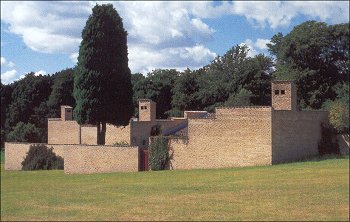
* The Fredensborg Houses - 1962-1965
* Bagsværd Church - 1968 - 1976
* Paustian Furniture House, Østerbro - 1987
(The Sydney Opera House, Australia)
( Espansiva)
(Herning
School Complex)
(Can Lis)
(Kuwait National Assembly)
(Can Feliz)
Peder Vilhelm Jensen Klint - 1853-1930
Kaare Klint - 1888-1954
Esben Klint - 1915-1969
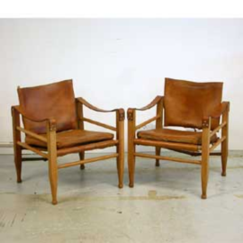
Henning Larsen
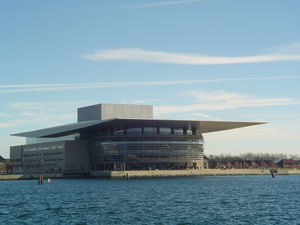
Arne Jacobsen
1902-1971
961
SAS Air Terminal at Copenhagen International Airport
St Catherine’s College, Oxford.
The Lifeguard towers at Bellevue Beach, Klampenborg -1933.
Aarhus City Hall - 1942
Bellavista Housing Development - 1934
Petrol Tank Station at Skovshoved - 1937
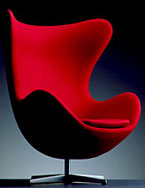
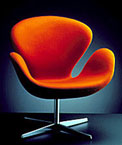
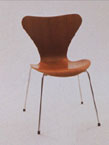
The Egg Chair - The Swan Chair - The 7 Chair.
The Cutlery used in the film '2001 Space Odyssy' etc., etc
--------------------------------------------
Famous Danish Design Names
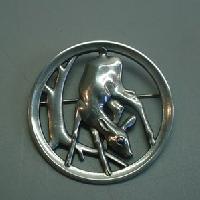
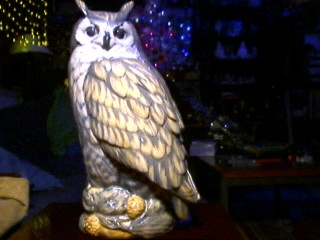
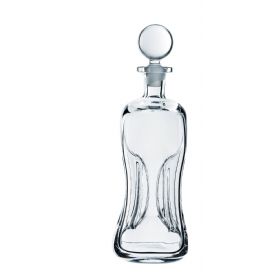
Per Lutgen - Holmegaard
Dahl Jensen - Porcelain Sculptor
Knud Kyhn - Ceramic/Porcelain sculptor
Børge Mogensen furniture
Hans J Wegner Furniture
Fritz Hansen - Furniture
Poul Kjærholm furniture (Louisiana Exhibition 2006)
Poul Henningsen
1894-1967
lamps-lights ( in Tivoli)
PH Lamp - 1925
Artichoke lamp - 1958
A Grand Piano For The Humble Home - - 1931
Verner Panton Lamps-Lighting
Louis Poulsen - lamps-lights ( Nyhavn 11)
Lego - Toys
Bang and Olufsen - Hi Fi
Bodum - Plastic design tea/coffee crockery etc
Nilfisk - vacuum cleaners
Mads Stage - Artist
Bjorn Wiiblad - Artist / Ceramic /porcelain artist
Piet Hein
1905 - 1996
Grooks (Short Poems)
The Sinus Lamp - 1967
The Super Egg - 1967
The Superellipse -1959
Moving dolls eyes - 1930'2
Kay Bojesen
--------------------------------------------------------------------------------------
Interesting places to Visit
*Danish Architecture Center
(Strandgade 27B)* Danish Design Center
(H C Andersens Boulevard 27)* Illums Bolighus / Royal Copenhagen / Georg Jensen
(Amagertorv 4-10, Strøget)* Royal Copenhagen Porcelain Factory,
(Nordre Fasansvej)* Museum of Applied (Decorative) Art and Industrial Design
* Ny Carlsberg Glyptotek -
Art & Sculpture (French Impressionists) (Dantes Plads 7)* Statens Museum For Kunst (National Art Gallery)
*
Henry Heerup Museum , (Kirkesvinget 1, Rødovre)*
The Ark, (Skovvej 100, Ishøj)* Louisiana,
Modern Art Gallery (Gamle Strandvej 13,Humlebæk).* Form and Design Center, ( Hedman’s Courtyard, Lilla Torg, Malmo)
* The Turning Torso ,(Santiago Calatravas) (Vastra Hamnen, Malmo) - ( via Øresundsbroen)

Link to Taxi & Limousine Sightseeing Tours
For more information please contact : Paul H Wilson
scandibalt@yahoo.com
------------------------------------------------------------------------------------
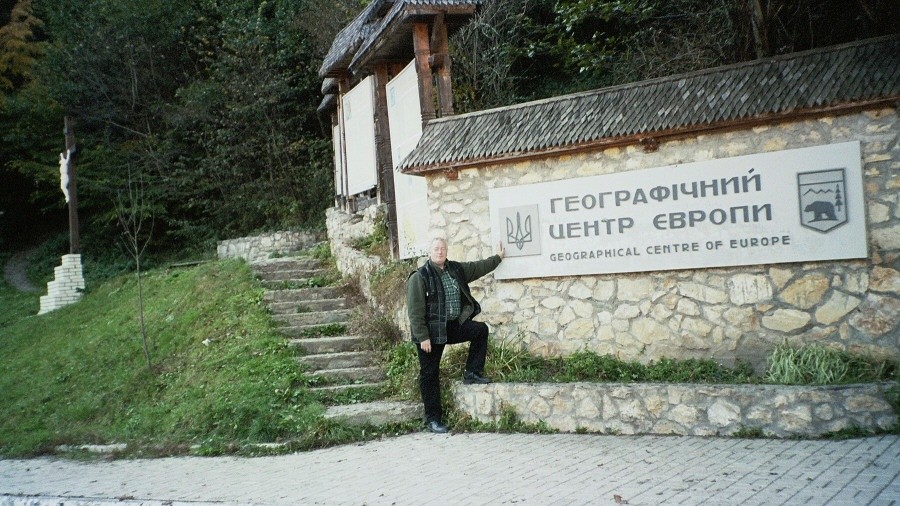
Paul H Wilson - ISAT Founder
visiting the Geographical Centre of Europe
Carpathian Mountains, Ukraine 2006
Qualified English Limousine & Taxi Sightseeing Guide / Chauffeur
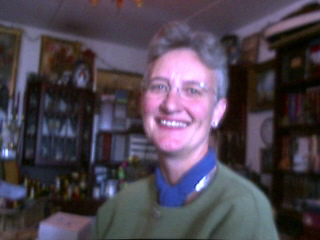
*
Lis Frederiksen
- ISAT Associate Sightseeing Guide
who is working as an international tour guide
and is also available for guided walking
sightseeing tours around Copenhagen City
and as a guide with Taxi or Limousines .
(Where the driver is not a Trained Sightseeing guide)
* Niels
Pederesen - Reserve Associate Driver
Alpha Limousine and Taxinord Vognmand
2 x Mercedes 'S' Class Limousines / 1 x Mercedes Viano
Limousine van /
2 x VW Transporter Limousine vans /
4 x Mercedes 'E ' Class Taxi Cars / 1 x VW Touran Taxi Car
* Hans Tullberg - Reserve Associate Sightseing driver and guide
* Peter
Hvolby - Reserve Associate Driver
Taxinord Vognmand - VW Touran Taxi Car
---------------------------------------------------------------------------------